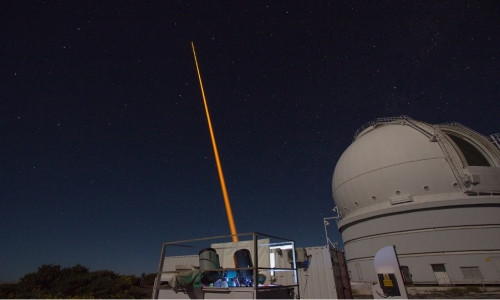Atmospheric Tip-Tilt from Laser Guide Star- Advancing the LGS Side Projection method
Introduction
Laser Guide Star Adaptive Optics (LGS-AO) is a technique in use already in many professional observatories around the world. The use of Laser Guide Stars (LGS) has enlarged the sky coverage of adaptive optics by a large fraction, but not to 100% level. The atmospheric tip-tilt could not be determined by the laser guide star – so far.
This PhD thesis aims at studying one specific method to derive the tip-tilt from Laser Guide Stars theoretically and experimentally. The achievement of this goal would have a large impact on the sky coverage of LGS-AO systems, both for astronomical instrumentation and for space applications, such as optical communication with satellites and space situational awareness.
Three different techniques have been proposed to derive the tip-tilt of the atmospheric turbulence from LGS:
1. Side projection view of the LGS plume;
2. Time delay method, applicable with monostatic systems like CaNaPy;
3. Polychromatic Laser Guide Star
We propose a PhD thesis on laser guide stars adaptive optics focused on Advancing the LGS Side Projection method. The goal of this work is to develop a complete theoretical and experimental validation of this method, which, if proved feasible for implementation, may lead to further development for LGS-AO systems. The candidate will take a leading role in conducting the side projection view experiment using the ESO Wendelstein Laser Guide Star experimental facility located in the Roque de Los Muchachos Observatory in La Palma (Canary Islands), which employs a world-unique 70+ W guide star laser. The candidate will have the opportunity as well to participate in upgrades to the facility and to provide support to hosted experiments, as required. Upon successful completion of the PhD, the candidate will acquire the necessary expertise to be at the forefront of LGS technology and wavefront sensing.
The PhD work would be done at ESO, in collaboration with ESA and INAF-OAR scientists and technologists.
The supervisors of the thesis will be Dr. F. Pedreros Bustos (ESO) and Dr. R. Holzlöhner (ESO)
Dr. D. Bonaccini Calia (at ESO up to Nov 2023 and at INAF-OAR from Dec. 2023), will offer expert guidance and close advisory support.

The ESO Wendelstein Laser Guide Star Unit (WLGSU) next to the William Herschel Telescope in La Palma, will be used to develop the perspective method experiments.
Desired skillset:
The successful candidate will have masters’ equivalent degree in physics/engineering or similar, with previous experience in experimental/practical work (laboratory, electronics, optics/instruments design, observational astronomy, etc.). Knowledge in adaptive optics, lasers, and optical atmospheric propagation will be advantageous, as well as experience working in multidisciplinary and international teams. The candidate must be willing to travel, work in the lab and in the observatory on the Canary Islands, and to be proficient in English.
Research objectives:
A. Literature review and motivation for the use of the three different methods, with emphasis in side projection view method.
B. Develop an end-to-end model of the method (numerical/analytical) based on AO software tools, e.g. PASSATA, OOMAO, etc.
C. Develop an upgrade experimental procedure (software, hardware, optomechanics) as necessary.
D. Perform on-sky experiments to verify the method at the WLGSU in La Palma.
E. Evaluate the performance of the experiment in terms of sky-coverage and residual wavefront error
F. Prepare and publish the results at international conferences and refereed journals.
Expected timeline:
- PhD Thesis Starts at ESO October 2023.
- Literature review Phase A. ends in February 2024
- Phase B ends in August 2024
- Phase C experimental development ends in March 2025
- Phase D two on-sky experiment missions in La Palma (May and Oct 2025)
- Phase E ends in winter 2026
- Phase F ends in summer 2026
- PhD Thesis ends December 2026
